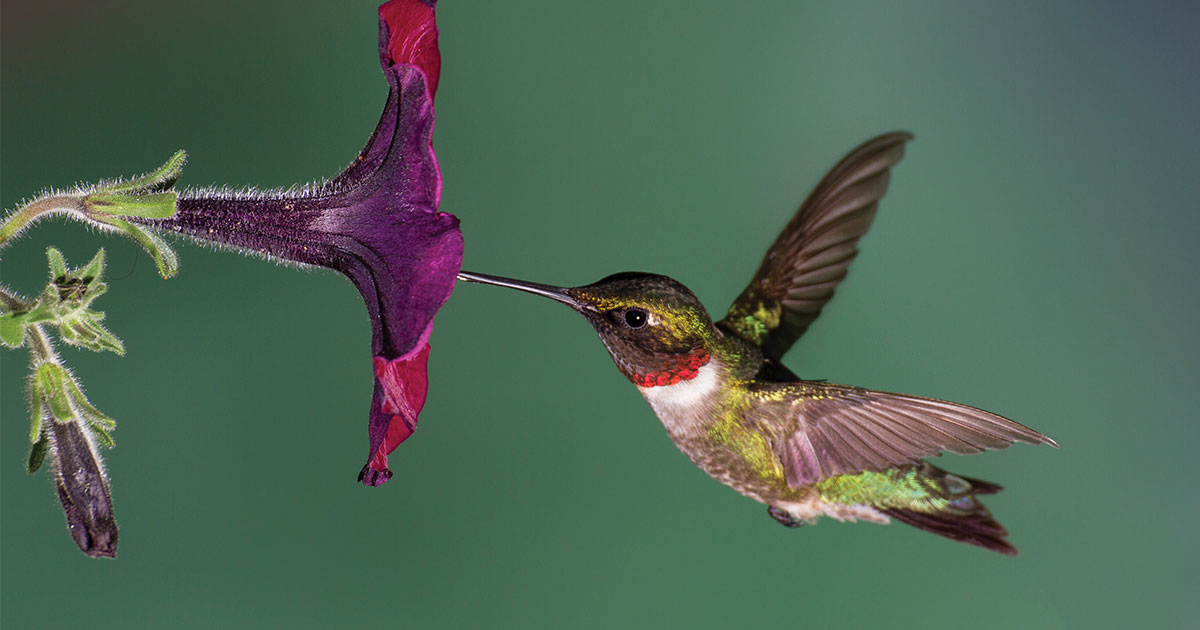IT’S APRIL, AND THE HUMMERS ARE BACK!
After traveling 500 miles from southern Mexico, they’ve finally arrived in our yards and gardens! Known as “flying jewels,” these tiny colorful creatures are a joy to watch when their iridescent plumage shimmers and shines as it catches rays of sunlight.
HELP HUMMERS REFUEL AFTER THEIR LONG MIGRATORY JOURNEY
They may be tiny, but they require a lot of food for fuel. From sunrise to sunset, hummingbirds must eat constantly. With fast breathing, fast heart rates, and high body temperature, they require a steady intake of food and have to gain at least half their body weight each day to replace the calories they burn up. If food is plentiful, they will happily consume up to three times their body weight daily. Hummingbirds eat up to 8 times per hour, but each feeding session lasts only about 30 seconds to 1 minute.
FOOD FERVOR & SAFE NECTAR RECIPE
Surprisingly, hummingbirds eat pollen, tree sap and insects, as well as nectar and sugar water. Making your own sugar water is easy, but always follow these few basic rules to be sure the nectar is safe: never use distilled water, artificial sweeteners, or brown sugar, and above all, never add honey or red food dye. Keep the feeder clean and replace the nectar once a week when the weather is cool. Replace the nectar every other day or even every day once it gets really hot outside. It’s simple to make a safe hummingbird nectar: mix 1 part sugar with four parts water. Bring to a boil, cool and fill the feeder. Store extra nectar in the refrigerator for up to two weeks.
RAVISHING RED ATTRACTS HUMMINGBIRDS
Hummingbirds are visual creatures, relying on bright colors to locate their food instead of relying on their sense of smell. Hummingbirds are easy to attract with the color red, so choose a red feeder with decorative red accents. A hummingbird-friendly habitat includes a water source plus a variety of flowering shrubs, herbs and vines that provide safety, shade, and food.
FAVORITE FLOWERS
For natural sources of nectar nourishment, opt for brightly-colored, tube-shaped flowers, such as Columbine, Daylily, Bee Balm, Lupine, Hollyhock, and Foxglove. Other flowers known to attract the hummingbird population are Beard Tongue, Catnip, Butterfly Bush, Desert Candle, Iris, Flowering Tobacco, Petunia, Soapwort, and Verbena.
HUMM . . . SO, WHY ARE THEY CALLED “HUMMERS?”
Hummers make a distinctive humming sound as they rapidly flap their wings anywhere from 50 to 80 times per second. They make other sounds, too, from a quick series of common calls described as “chee-dit” to chirps, buzzes, and whistles.
AWESOME AERIAL ACROBATICS
Flit, from Disney’s Pocahontas, is the perfect name for a hummingbird since hummingbirds flit fast in every direction. They fly upside down and backward and can hover in midair while flapping their wings in a shallow figure-8 pattern.
AMAZING ANATOMY
These tiny birds weigh less than an ounce and are only about 2 inches long. They have slender, tapered beaks that can dip into tubular flowers like honeysuckle. The hummingbird’s feet are not used for walking or hopping, but for perching. Their heart rates can be around 1260 beats per minute, and they are rapid breathers, breathing about 250 breaths per minute.
RANGE AND LOCATION
There are over 300 species of hummingbirds, 12 of which spend their summers in North America and their winters in the tropics. They are found in the western hemisphere, from southeastern Alaska to southern Chile. The most common hummingbird east of the Mississippi is the Ruby-Throated Hummingbird (Archilochus Colubris).
BOLD BRAVE BIRDS
Hummingbirds are often territorial and have been known to chase each other, as well as sometimes even chasing hawks away from their homes and habitats.
Watching these zippy, agile tiny birds go about your garden and fuel up at your feeder(s) can be a richly rewarding experience, bringing you much joy and amusement. Do all you can to help prepare for their spring arrival. Early April is a good time to put your hummingbird feeders out for early migrants. Enjoy these special birds’ company as spring unfurls its full natural beauty.





















